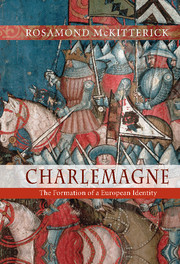Book contents
- Frontmatter
- Dedication
- Contents
- List of maps
- List of tables
- Preface
- List of abbreviations
- 1 Representations of Charlemagne
- 2 Pippinids, Arnulfings and Agilolfings: the creation of a dynasty
- 3 The royal court
- 4 The king and the kingdom: communications and identities
- 5 Correctio, knowledge and power
- Bibliography
- Index of manuscripts
- General index
2 - Pippinids, Arnulfings and Agilolfings: the creation of a dynasty
Published online by Cambridge University Press: 05 August 2015
- Frontmatter
- Dedication
- Contents
- List of maps
- List of tables
- Preface
- List of abbreviations
- 1 Representations of Charlemagne
- 2 Pippinids, Arnulfings and Agilolfings: the creation of a dynasty
- 3 The royal court
- 4 The king and the kingdom: communications and identities
- 5 Correctio, knowledge and power
- Bibliography
- Index of manuscripts
- General index
Summary
INTRODUCTION: PERCEPTIONS OF THE EIGHTH CENTURY AND THE RISE OF THE CAROLINGIANS
Charlemagne's forebears, the Pippinids, rather than the Merovingian kings, dominate court-associated history, family histories and local annals alike in the later seventh and the eighth centuries. Charlemagne's great grandfather and grandfather, Pippin II and Charles Martel, served as mayors of the Merovingian royal palace and were descended from the union between Ansegisel, son of Arnulf, bishop of Metz, and Begga, daughter of Pippin I (hence Pippinids) (see Table 1). Thus the courtassociated narrative of the Annales regni francorum, discussed in the preceding chapter, begins in 741 with the death of Charles Martel, Charlemagne's grandfather. Einhard, as we have seen, opened his Vita Karoli with the taking of the kingship by Pippin III, son of Charles Martel, and the notorious portrait of the last Merovingian king who merely sat on his throne and played at being a ruler. In this way, Einhard heightened the contrast between the strong Pippinids and the feeble dynasty of Merovingian kings that Pippin III replaced. Even the narrative of the Liber historiae francorum, completed c. 727 and usually classified as a non-Carolingian source, concedes much of its space in the later chapters of the work to the Pippinid mayors, and concludes with the initial triumph of Charles Martel over Ragamfred, the Neustrian mayor of the palace, and King Chilperic. Carolingian scribes, moreover, such as the person responsible for the Frankish history book now in Paris, BnF lat. 10911, contrived by clever juxtapositioning to present the Liber historiae francorum from the Carolingian perspective. This codex also incorporated sections of the Continuations of Fredegar's Chronicle, that is, the partial (in both senses) record of the triumphant careers of Pippin II, and of Charles Martel and his sons written under the auspices of Charles Martel's half-brother Childebrand and Childebrand's son Nibelung.
- Type
- Chapter
- Information
- CharlemagneThe Formation of a European Identity, pp. 57 - 136Publisher: Cambridge University PressPrint publication year: 2008



